
Easy Tips to set up a Worm Farm
Have you ever heard people talk about worm farms and wondered if there’s farmers out there who are letting millions of worms graze on the grass in their paddocks?
Ok so we know nobody really thinks that, but what we do know is that there isn’t a lot of clarity out there on how worm farms really work, or how people go about setting them up. So rest assured, friends – we’re here to help!
What exactly is a worm farm?
A worm farm is a container where you can put your organic waste materials and lots and lots of wiggly worm friends. These wriggly critters will happily turn that waste into an amazing natural fertilizer for your garden. Worm farms can vary in size, which means they are ideal for those people with backyards as well as those with even the smallest of yards, courtyards or balconies.
What materials do you need to set up a worm farm?
 Image sourced: Google images
Image sourced: Google images
- A Worm Farm: the best thing to do is to purchase the specially made two or three layer container required for a worm farm. These can usually be found at your local garden/hardware stores and are often available through some local councils. There are also lots of videos on YouTube detailing how to make your own if you feel particularly creative!
- Wiggly Compost Worms: you can purchase compost worms from so many places, ranging from your local garden and hardware stores to specific composting worm farms where you can have them delivered to your door. You would normally start with at least 1000 worms, and you would increase from there depending on how much organic waste your household produces.
- Newspaper/Cardboard/Bedding Block: these items are used to form the base of the worm farm on the bottom layer.
- Hessian sack: used to cover the top layer of organic scraps
- Food scraps/compost: the last piece of the puzzle - you need your organic food scraps (you cannot put garlic, onion, dairy, citrus fruits, chilli, meat/bones, fish or oil into the worm farm) and then some compost.
- Step 1: you need to line the bottom or ‘home’ tray of the worm farm with the cardboard and newspaper that you have. It is best if you cut it to the size and shape that fits your container perfectly.
- Step 2: soak the bedding block in some water until it starts to break up (about 30mins) and then you can break it apart and spread it over the cardboard base you’ve already put down.
- Step 3: add a layer of compost on top of the bedding block
- Step 4: add your worms and make sure that it is filled to the top
- Step 5: on the top or ‘working’ tray you can add some more compost and your food scraps (try to cut the scraps into smaller pieces to make it easier for the worms to digest). Make sure that you cover the scraps with the hessian sack for insulation and protection.
 Image sourced: Google images
Image sourced: Google images
